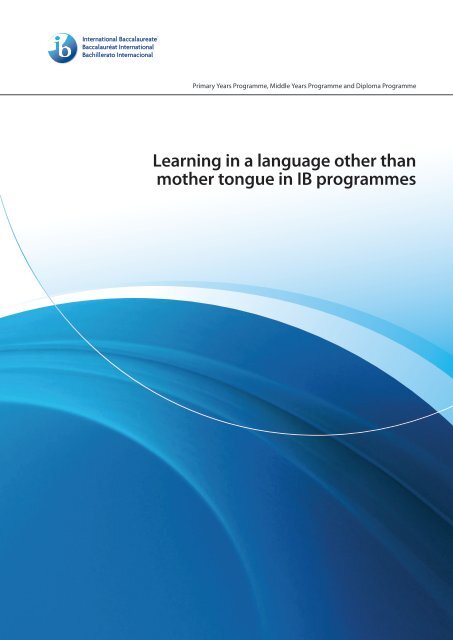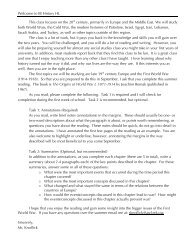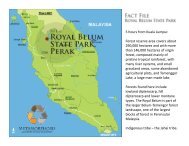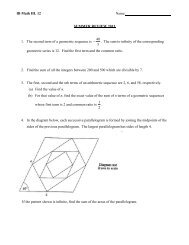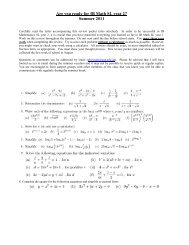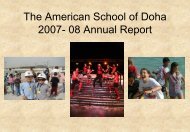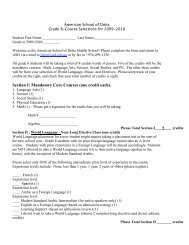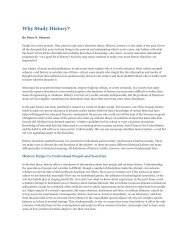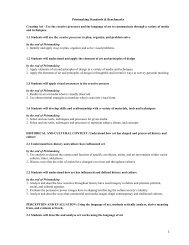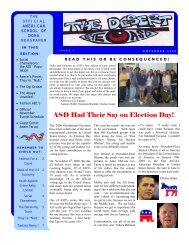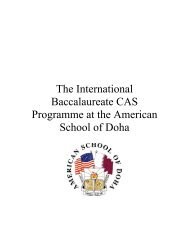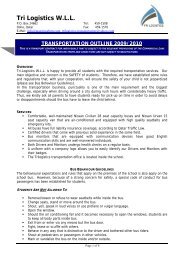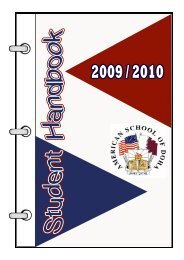Learning in a language other than mother tongue in IB programmes
Learning in a language other than mother tongue in IB programmes
Learning in a language other than mother tongue in IB programmes
Create successful ePaper yourself
Turn your PDF publications into a flip-book with our unique Google optimized e-Paper software.
Primary Years Programme, Middle Years Programme and Diploma Programme<br />
<strong>Learn<strong>in</strong>g</strong> <strong>in</strong> a <strong>language</strong> <strong>other</strong> <strong>than</strong><br />
m<strong>other</strong> <strong>tongue</strong> <strong>in</strong> <strong>IB</strong> <strong>programmes</strong>
Primary Years Programme, Middle Years Programme and Diploma Programme<br />
<strong>Learn<strong>in</strong>g</strong> <strong>in</strong> a <strong>language</strong> <strong>other</strong> <strong>than</strong><br />
m<strong>other</strong> <strong>tongue</strong> <strong>in</strong> <strong>IB</strong> <strong>programmes</strong>
Primary Years Programme, Middle Years Programme<br />
and Diploma Programme<br />
<strong>Learn<strong>in</strong>g</strong> <strong>in</strong> a <strong>language</strong> <strong>other</strong> <strong>than</strong> m<strong>other</strong> <strong>tongue</strong><br />
<strong>in</strong> <strong>IB</strong> <strong>programmes</strong><br />
Published April 2008<br />
International Baccalaureate<br />
Peterson House, Malthouse Avenue, Cardiff Gate<br />
Cardiff, Wales GB CF23 8GL<br />
United K<strong>in</strong>gdom<br />
Phone: +44 29 2054 7777<br />
Fax: +44 29 2054 7778<br />
Website: http://www.ibo.org<br />
© International Baccalaureate Organization 2008<br />
The International Baccalaureate (<strong>IB</strong>) offers three high quality and challeng<strong>in</strong>g<br />
educational <strong>programmes</strong> for a worldwide community of schools, aim<strong>in</strong>g to create a<br />
better, more peaceful world.<br />
The <strong>IB</strong> is grateful for permission to reproduce and/or translate any copyright material<br />
used <strong>in</strong> this publication. Acknowledgments are <strong>in</strong>cluded, where appropriate, and,<br />
if notified, the <strong>IB</strong> will be pleased to rectify any errors or omissions at the earliest<br />
opportunity.<br />
All rights reserved. No part of this publication may be reproduced, stored <strong>in</strong> a retrieval<br />
system, or transmitted, <strong>in</strong> any form or by any means, without the prior written<br />
permission of the <strong>IB</strong>, or as expressly permitted by law or by the <strong>IB</strong>’s own rules and<br />
policy. See http://www.ibo.org/copyright.<br />
<strong>IB</strong> merchandise and publications can be purchased through the <strong>IB</strong> store at<br />
http://store.ibo.org. General order<strong>in</strong>g queries should be directed to the sales and<br />
market<strong>in</strong>g department <strong>in</strong> Cardiff.<br />
Phone: +44 29 2054 7746<br />
Fax: +44 29 2054 7779<br />
Email: sales@ibo.org
<strong>IB</strong> mission statement<br />
The International Baccalaureate aims to develop <strong>in</strong>quir<strong>in</strong>g, knowledgeable and car<strong>in</strong>g young people who help to<br />
create a better and more peaceful world through <strong>in</strong>tercultural understand<strong>in</strong>g and respect.<br />
To this end the organization works with schools, governments and <strong>in</strong>ternational organizations to develop<br />
challeng<strong>in</strong>g <strong>programmes</strong> of <strong>in</strong>ternational education and rigorous assessment.<br />
These <strong>programmes</strong> encourage students across the world to become active, compassionate and lifelong learners<br />
who understand that <strong>other</strong> people, with their differences, can also be right.<br />
<strong>IB</strong> learner profile<br />
The aim of all <strong>IB</strong> <strong>programmes</strong> is to develop <strong>in</strong>ternationally m<strong>in</strong>ded people who, recogniz<strong>in</strong>g their common<br />
humanity and shared guardianship of the planet, help to create a better and more peaceful world.<br />
<strong>IB</strong> learners strive to be:<br />
Inquirers<br />
Knowledgeable<br />
Th<strong>in</strong>kers<br />
Communicators<br />
Pr<strong>in</strong>cipled<br />
Open-m<strong>in</strong>ded<br />
Car<strong>in</strong>g<br />
Risk-takers<br />
Balanced<br />
Reflective<br />
They develop their natural curiosity. They acquire the skills necessary to conduct <strong>in</strong>quiry<br />
and research and show <strong>in</strong>dependence <strong>in</strong> learn<strong>in</strong>g. They actively enjoy learn<strong>in</strong>g and this<br />
love of learn<strong>in</strong>g will be susta<strong>in</strong>ed throughout their lives.<br />
They explore concepts, ideas and issues that have local and global significance. In so<br />
do<strong>in</strong>g, they acquire <strong>in</strong>-depth knowledge and develop understand<strong>in</strong>g across a broad and<br />
balanced range of discipl<strong>in</strong>es.<br />
They exercise <strong>in</strong>itiative <strong>in</strong> apply<strong>in</strong>g th<strong>in</strong>k<strong>in</strong>g skills critically and creatively to recognize and<br />
approach complex problems, and make reasoned, ethical decisions.<br />
They understand and express ideas and <strong>in</strong>formation confidently and creatively <strong>in</strong> more<br />
<strong>than</strong> one <strong>language</strong> and <strong>in</strong> a variety of modes of communication. They work effectively<br />
and will<strong>in</strong>gly <strong>in</strong> collaboration with <strong>other</strong>s.<br />
They act with <strong>in</strong>tegrity and honesty, with a strong sense of fairness, justice and respect<br />
for the dignity of the <strong>in</strong>dividual, groups and communities. They take responsibility for<br />
their own actions and the consequences that accompany them.<br />
They understand and appreciate their own cultures and personal histories, and are open<br />
to the perspectives, values and traditions of <strong>other</strong> <strong>in</strong>dividuals and communities. They are<br />
accustomed to seek<strong>in</strong>g and evaluat<strong>in</strong>g a range of po<strong>in</strong>ts of view, and are will<strong>in</strong>g to grow<br />
from the experience.<br />
They show empathy, compassion and respect towards the needs and feel<strong>in</strong>gs of <strong>other</strong>s.<br />
They have a personal commitment to service, and act to make a positive difference to the<br />
lives of <strong>other</strong>s and to the environment.<br />
They approach unfamiliar situations and uncerta<strong>in</strong>ty with courage and forethought, and<br />
have the <strong>in</strong>dependence of spirit to explore new roles, ideas and strategies. They are brave<br />
and articulate <strong>in</strong> defend<strong>in</strong>g their beliefs.<br />
They understand the importance of <strong>in</strong>tellectual, physical and emotional balance to<br />
achieve personal well-be<strong>in</strong>g for themselves and <strong>other</strong>s.<br />
They give thoughtful consideration to their own learn<strong>in</strong>g and experience. They are able<br />
to assess and understand their strengths and limitations <strong>in</strong> order to support their learn<strong>in</strong>g<br />
and personal development.<br />
© International Baccalaureate Organization 2007
Contents<br />
Introduction 1<br />
Preface 1<br />
Purpose of this document 2<br />
<strong>Learn<strong>in</strong>g</strong> <strong>in</strong> a <strong>language</strong> <strong>other</strong> <strong>than</strong> m<strong>other</strong> <strong>tongue</strong> 3<br />
Philosophical underp<strong>in</strong>n<strong>in</strong>gs 3<br />
A conceptual framework of <strong>language</strong> and learn<strong>in</strong>g 4<br />
<strong>Learn<strong>in</strong>g</strong> <strong>language</strong> 4<br />
<strong>Learn<strong>in</strong>g</strong> through <strong>language</strong> 5<br />
<strong>Learn<strong>in</strong>g</strong> about <strong>language</strong> 5<br />
Conditions for learn<strong>in</strong>g 6<br />
Activate prior understand<strong>in</strong>g and build background knowledge 6<br />
Scaffold mean<strong>in</strong>g 7<br />
Extend <strong>language</strong> 8<br />
Affirm identity 8<br />
General implications for practice 9<br />
Appendices 10<br />
References 10<br />
Suggested further read<strong>in</strong>gs 11<br />
<strong>Learn<strong>in</strong>g</strong> <strong>in</strong> a <strong>language</strong> <strong>other</strong> <strong>than</strong> m<strong>other</strong> <strong>tongue</strong> <strong>in</strong> <strong>IB</strong> <strong>programmes</strong>
Introduction<br />
Preface<br />
Language stands at the center of the many <strong>in</strong>terdependent cognitive, affective,<br />
and social factors that shape learn<strong>in</strong>g.<br />
Corson (1999)<br />
Language is <strong>in</strong>tegral to explor<strong>in</strong>g and susta<strong>in</strong><strong>in</strong>g personal development, cultural identity and <strong>in</strong>tercultural<br />
understand<strong>in</strong>g. As well as be<strong>in</strong>g the major medium of social communication, it is tightly l<strong>in</strong>ked to cognitive<br />
growth because it is the process by which mean<strong>in</strong>g and knowledge is negotiated and constructed. It is<br />
the ma<strong>in</strong> tool for build<strong>in</strong>g our knowledge of the universe and our place <strong>in</strong> it. Language then, is central to<br />
learn<strong>in</strong>g, as well as to literacy, and is thus closely related to success <strong>in</strong> school.<br />
As a result of the global population’s <strong>in</strong>creas<strong>in</strong>g mobility, many learners <strong>in</strong> schools are construct<strong>in</strong>g<br />
knowledge <strong>in</strong> a <strong>language</strong> that is not their m<strong>other</strong> <strong>tongue</strong>. A <strong>language</strong> profile of any one of these learners<br />
may demonstrate two or more <strong>language</strong>s <strong>in</strong> his or her learn<strong>in</strong>g cont<strong>in</strong>uum. This situation has created new<br />
challenges for learners, teachers and schools who, <strong>in</strong> the past, have assumed a common monol<strong>in</strong>gual,<br />
monocultural sett<strong>in</strong>g. Various responses to these challenges, together with prolific research, have resulted <strong>in</strong><br />
a wealth of expertise on good practices that nurture the valuable diversity of multil<strong>in</strong>gual and multicultural<br />
classrooms to its full potential <strong>in</strong> develop<strong>in</strong>g <strong>in</strong>ternationally m<strong>in</strong>ded people. The <strong>IB</strong> is committed to shar<strong>in</strong>g<br />
this expertise with all stakeholders.<br />
Along with the research relat<strong>in</strong>g to <strong>language</strong> and learn<strong>in</strong>g, there has been an expansion of jargon.<br />
Terms for learners such as English as a second <strong>language</strong> (ESL), English as an additional <strong>language</strong> (EAL),<br />
second <strong>language</strong> learn<strong>in</strong>g (SLL) and English speakers of <strong>other</strong> <strong>language</strong>s (ESOL) carry with them differ<strong>in</strong>g<br />
connotations depend<strong>in</strong>g on cultural context. The term of reference <strong>in</strong> this document will be “learners who<br />
are learn<strong>in</strong>g <strong>in</strong> a <strong>language</strong> <strong>other</strong> <strong>than</strong> their m<strong>other</strong> <strong>tongue</strong>”. The term m<strong>other</strong> <strong>tongue</strong> is used <strong>in</strong> the<br />
research literature <strong>in</strong> various ways. It may denote the <strong>language</strong> learned first; the <strong>language</strong> identified with<br />
as a “native” speaker; the <strong>language</strong> known best; the <strong>language</strong> used most. When used <strong>in</strong> this document, it<br />
<strong>in</strong>cludes all those mean<strong>in</strong>gs.<br />
<strong>Learn<strong>in</strong>g</strong> <strong>in</strong> a <strong>language</strong> <strong>other</strong> <strong>than</strong> m<strong>other</strong> <strong>tongue</strong> <strong>in</strong> <strong>IB</strong> <strong>programmes</strong><br />
1
Introduction<br />
Purpose of this document<br />
Many learners <strong>in</strong> <strong>IB</strong> <strong>programmes</strong> have rich and complex multil<strong>in</strong>gual backgrounds. This means a large<br />
number of learners must access the majority of an <strong>IB</strong> programme curriculum <strong>in</strong> a <strong>language</strong> <strong>other</strong> <strong>than</strong> their<br />
m<strong>other</strong> <strong>tongue</strong>. A thorough understand<strong>in</strong>g of how this situation impacts on learn<strong>in</strong>g is essential if schools<br />
are to ensure that the value of the learner diversity is not lost, that there is equal access to the curriculum<br />
for all learners and that the standards of conditions and practices <strong>in</strong> place foster a successful teach<strong>in</strong>g and<br />
learn<strong>in</strong>g environment for everyone.<br />
This document therefore provides a conceptual framework of <strong>language</strong> and learn<strong>in</strong>g that is applicable to<br />
all <strong>IB</strong> learners. The particular implications for schools <strong>in</strong> guarantee<strong>in</strong>g equal access to an <strong>IB</strong> programme for<br />
learners who are learn<strong>in</strong>g <strong>in</strong> a <strong>language</strong> <strong>other</strong> <strong>than</strong> their m<strong>other</strong> <strong>tongue</strong> are also described.<br />
2<br />
<strong>Learn<strong>in</strong>g</strong> <strong>in</strong> a <strong>language</strong> <strong>other</strong> <strong>than</strong> m<strong>other</strong> <strong>tongue</strong> <strong>in</strong> <strong>IB</strong> <strong>programmes</strong>
<strong>Learn<strong>in</strong>g</strong> <strong>in</strong> a <strong>language</strong> <strong>other</strong> <strong>than</strong> m<strong>other</strong> <strong>tongue</strong><br />
Philosophical underp<strong>in</strong>n<strong>in</strong>gs<br />
The <strong>IB</strong> offers three high quality and challeng<strong>in</strong>g educational <strong>programmes</strong> for a worldwide community of<br />
schools, aim<strong>in</strong>g to create a better, more peaceful world through <strong>in</strong>tercultural understand<strong>in</strong>g and respect.<br />
Crucial for the success of the <strong>programmes</strong> is a rich development of <strong>language</strong> and literacy for all learners. The<br />
ability to communicate <strong>in</strong> a variety of modes <strong>in</strong> more <strong>than</strong> one <strong>language</strong> is essential to the concept of an<br />
<strong>in</strong>ternational education that promotes <strong>in</strong>tercultural understand<strong>in</strong>g. Consequently, this requirement is built<br />
<strong>in</strong>to the standards and practices of all three <strong>IB</strong> <strong>programmes</strong> as well as the <strong>IB</strong> learner profile. Recogniz<strong>in</strong>g that<br />
the <strong>language</strong> profiles of <strong>IB</strong> learners are diverse, and that sometimes one <strong>language</strong> may be more dom<strong>in</strong>ant<br />
<strong>than</strong> an<strong>other</strong> <strong>in</strong> the same <strong>in</strong>dividual, <strong>IB</strong> <strong>programmes</strong> offer a variety of opportunities for learn<strong>in</strong>g more <strong>than</strong><br />
one <strong>language</strong>.<br />
Learners access<strong>in</strong>g an <strong>IB</strong> programme <strong>in</strong> a <strong>language</strong> <strong>other</strong> <strong>than</strong> their m<strong>other</strong> <strong>tongue</strong> are potentially able<br />
to become balanced bil<strong>in</strong>guals who are highly proficient, literate and knowledgeable <strong>in</strong> two or more<br />
<strong>language</strong>s. The <strong>IB</strong> recognizes this valuable potential and the need for guidel<strong>in</strong>es for schools on the best<br />
practices for its nurture. Therefore, this document provides a framework for understand<strong>in</strong>g <strong>language</strong> and<br />
learn<strong>in</strong>g, and how it <strong>in</strong>forms good practice <strong>in</strong> <strong>IB</strong> <strong>programmes</strong>.<br />
<strong>Learn<strong>in</strong>g</strong> <strong>in</strong> a <strong>language</strong> <strong>other</strong> <strong>than</strong> m<strong>other</strong> <strong>tongue</strong> <strong>in</strong> <strong>IB</strong> <strong>programmes</strong><br />
3
<strong>Learn<strong>in</strong>g</strong> <strong>in</strong> a <strong>language</strong> <strong>other</strong> <strong>than</strong> m<strong>other</strong> <strong>tongue</strong><br />
A conceptual framework of <strong>language</strong> and learn<strong>in</strong>g<br />
Almost all education is <strong>language</strong> education.<br />
Postman (1996)<br />
Language learn<strong>in</strong>g <strong>in</strong> school is not a separate discipl<strong>in</strong>e isolated from all <strong>other</strong> learn<strong>in</strong>g (except when studied<br />
as l<strong>in</strong>guistics). As well as be<strong>in</strong>g part of social and personal development, <strong>language</strong> learn<strong>in</strong>g <strong>in</strong> school is<br />
crucial for academic cognitive growth and the construction of knowledge. The <strong>language</strong> of academic<br />
discourses and the mean<strong>in</strong>g and the knowledge content of any one discipl<strong>in</strong>e are closely <strong>in</strong>terwoven. For<br />
example, the discourse of mathematics is dist<strong>in</strong>ct from the discourse of history and, <strong>in</strong> each case, is <strong>in</strong>tegral<br />
to construct<strong>in</strong>g mean<strong>in</strong>g. Similarly, the discourses of <strong>in</strong>terpersonal communications vary depend<strong>in</strong>g on<br />
purpose. The <strong>language</strong> of a compla<strong>in</strong>t will be different from that of a wedd<strong>in</strong>g <strong>in</strong>vitation. The features of<br />
different discourses have been identified and are described <strong>in</strong> l<strong>in</strong>guistic genre theory.<br />
A l<strong>in</strong>guistic genre is a particular text type created by a specific communicative situation. Examples of some<br />
common genres used <strong>in</strong> school are recount, narrative, report, explanation, argument and discussion. As<br />
learners <strong>in</strong> schools build knowledge <strong>in</strong> and across discipl<strong>in</strong>es, they move along a cont<strong>in</strong>uum of <strong>language</strong><br />
and learn<strong>in</strong>g that <strong>in</strong>cludes an ability to use and understand a range of academic l<strong>in</strong>guistic genres.<br />
A conceptual understand<strong>in</strong>g of the <strong>language</strong> and learn<strong>in</strong>g cont<strong>in</strong>uum is critical <strong>in</strong> determ<strong>in</strong><strong>in</strong>g what should<br />
be the focus <strong>in</strong> the processes of <strong>language</strong> teach<strong>in</strong>g and learn<strong>in</strong>g. It will <strong>in</strong>form the stag<strong>in</strong>g of these processes<br />
<strong>in</strong> the curriculum as well as the k<strong>in</strong>ds of materials used and developed for learn<strong>in</strong>g.<br />
Halliday (1985) expresses some of the complexity of the relationship between <strong>language</strong> and learn<strong>in</strong>g<br />
when he talks about “learn<strong>in</strong>g <strong>language</strong>, learn<strong>in</strong>g through <strong>language</strong> and learn<strong>in</strong>g about <strong>language</strong>”.<br />
Three aspects of <strong>language</strong> and learn<strong>in</strong>g development are identified, although it must be emphasized that<br />
<strong>language</strong> development is a process of construct<strong>in</strong>g mean<strong>in</strong>g <strong>in</strong> which all three aspects, learn<strong>in</strong>g <strong>language</strong>,<br />
learn<strong>in</strong>g through <strong>language</strong> and learn<strong>in</strong>g about <strong>language</strong>, are operat<strong>in</strong>g at any one time. A separate<br />
exam<strong>in</strong>ation of each, however, can provide a fuller understand<strong>in</strong>g of what is <strong>in</strong>volved.<br />
<strong>Learn<strong>in</strong>g</strong> <strong>language</strong><br />
In the early stages of life when a child is first learn<strong>in</strong>g to communicate <strong>in</strong> a m<strong>other</strong> <strong>tongue</strong>, he or she is<br />
learn<strong>in</strong>g to use <strong>language</strong> symbolically <strong>in</strong> order to construct mean<strong>in</strong>g and to <strong>in</strong>teract. In a safe, secure and<br />
nurtur<strong>in</strong>g environment, rich <strong>in</strong> stimulat<strong>in</strong>g experiences, the child exchanges signals with <strong>other</strong>s and learns<br />
to recognize, articulate and encode sounds, rhythms and <strong>in</strong>tonations while associat<strong>in</strong>g them with mean<strong>in</strong>gs<br />
or concepts. He or she may associate the sound “bo”, for example, with a ball and learn that by utter<strong>in</strong>g the<br />
word the m<strong>other</strong> is likely to respond <strong>in</strong> some way; perhaps by roll<strong>in</strong>g it for him. The child is build<strong>in</strong>g up a<br />
resource for mean<strong>in</strong>g.<br />
The child is also develop<strong>in</strong>g what Cumm<strong>in</strong>s (1979) calls basic <strong>in</strong>terpersonal communicative skills or BICS.<br />
This is the dimension of <strong>language</strong> that will enable a child to <strong>in</strong>teract socially with teachers and peers when<br />
he or she beg<strong>in</strong>s school. The <strong>language</strong> of such communication is supported by contextual cues as well as<br />
by gestures and facial expressions. Learners who already have communicative skills <strong>in</strong> a m<strong>other</strong> <strong>tongue</strong> may<br />
become functional <strong>in</strong> social communication <strong>in</strong> an<strong>other</strong> <strong>language</strong> with<strong>in</strong> two years because of the transfer of<br />
understand<strong>in</strong>g already <strong>in</strong> place.<br />
4<br />
<strong>Learn<strong>in</strong>g</strong> <strong>in</strong> a <strong>language</strong> <strong>other</strong> <strong>than</strong> m<strong>other</strong> <strong>tongue</strong> <strong>in</strong> <strong>IB</strong> <strong>programmes</strong>
A conceptual framework of <strong>language</strong> and learn<strong>in</strong>g<br />
As well as oral skills, the young child develops the early literacy skills of recogniz<strong>in</strong>g and manipulat<strong>in</strong>g<br />
symbols for decod<strong>in</strong>g and encod<strong>in</strong>g written texts <strong>in</strong> order to read and write. This <strong>in</strong>cludes learn<strong>in</strong>g to form<br />
the shapes of the letters or characters of a writ<strong>in</strong>g system and their phonetic associations. Learners who<br />
have basic literacy skills <strong>in</strong> their m<strong>other</strong> <strong>tongue</strong> are able to transfer some of these understand<strong>in</strong>gs and<br />
concepts when learn<strong>in</strong>g an<strong>other</strong> <strong>language</strong>.<br />
<strong>Learn<strong>in</strong>g</strong> <strong>language</strong> is ongo<strong>in</strong>g and is further fostered through read<strong>in</strong>g.<br />
<strong>Learn<strong>in</strong>g</strong> through <strong>language</strong><br />
At some po<strong>in</strong>t a child has enough <strong>language</strong> so that <strong>in</strong> addition to it be<strong>in</strong>g a communicative tool, it is also<br />
a flexible resource for further learn<strong>in</strong>g and cognitive growth. Language itself, rather <strong>than</strong> direct concrete<br />
experience, can be used to negotiate new mean<strong>in</strong>gs and construct knowledge about the world. Literacy<br />
becomes <strong>in</strong>creas<strong>in</strong>gly important <strong>in</strong> do<strong>in</strong>g this as more abstract learn<strong>in</strong>g takes place through dense academic<br />
texts <strong>in</strong> school. The ability to access the <strong>language</strong> of these texts is referred to as a cognitive academic<br />
<strong>language</strong> proficiency or CALP by Cumm<strong>in</strong>s (1979).<br />
For some learners <strong>in</strong> <strong>IB</strong> <strong>programmes</strong>, the <strong>language</strong> <strong>in</strong> which they are learn<strong>in</strong>g and develop<strong>in</strong>g their CALP is<br />
not the same as their m<strong>other</strong> <strong>tongue</strong> and this has implications for school organization as well as classroom<br />
practice. Depend<strong>in</strong>g on age and experience, for example, some learners may have a wealth of knowledge<br />
<strong>in</strong> a <strong>language</strong> <strong>other</strong> <strong>than</strong> that of the classroom. However, it can take up to seven years for learners who are<br />
us<strong>in</strong>g a <strong>language</strong> <strong>other</strong> <strong>than</strong> their m<strong>other</strong> <strong>tongue</strong> to atta<strong>in</strong> the same levels <strong>in</strong> academic <strong>language</strong> proficiency<br />
as those expected for learners learn<strong>in</strong>g <strong>in</strong> a m<strong>other</strong> <strong>tongue</strong>.<br />
<strong>Learn<strong>in</strong>g</strong> about <strong>language</strong><br />
Understand<strong>in</strong>g the relationship of <strong>language</strong> and mean<strong>in</strong>g and how <strong>language</strong> works <strong>in</strong> the construction<br />
of knowledge empowers the <strong>language</strong> user. A learner <strong>in</strong> an <strong>IB</strong> programme who has a critical <strong>language</strong><br />
awareness will be able to make choices about <strong>language</strong> use accord<strong>in</strong>g to his or her purpose and audience, as<br />
well as ga<strong>in</strong> <strong>in</strong>sight <strong>in</strong>to the <strong>language</strong> choices of <strong>other</strong>s. For example, an understand<strong>in</strong>g of various l<strong>in</strong>guistic<br />
genres means that a writer can choose the most appropriate genre for the task.<br />
Some learners who are learn<strong>in</strong>g <strong>in</strong> their m<strong>other</strong> <strong>tongue</strong> may have an <strong>in</strong>tuitive unconscious sense of how the<br />
<strong>language</strong> works and have a full range of choices and l<strong>in</strong>guistic genres available to them. Learners who are<br />
us<strong>in</strong>g a <strong>language</strong> <strong>other</strong> <strong>than</strong> their m<strong>other</strong> <strong>tongue</strong> to access an <strong>IB</strong> programme cannot always be assumed to<br />
have this awareness, which therefore needs to be explicitly taught <strong>in</strong> such circumstances.<br />
<strong>Learn<strong>in</strong>g</strong> <strong>in</strong> a <strong>language</strong> <strong>other</strong> <strong>than</strong> m<strong>other</strong> <strong>tongue</strong> <strong>in</strong> <strong>IB</strong> <strong>programmes</strong><br />
5
<strong>Learn<strong>in</strong>g</strong> <strong>in</strong> a <strong>language</strong> <strong>other</strong> <strong>than</strong> m<strong>other</strong> <strong>tongue</strong><br />
Conditions for learn<strong>in</strong>g<br />
A threshold level of proficiency <strong>in</strong> cognitive academic <strong>language</strong> is essential for the learner participation and<br />
engagement that is necessary for subsequent success <strong>in</strong> an <strong>IB</strong> programme.<br />
Cumm<strong>in</strong>s (2007) proposes that the four dimensions of teach<strong>in</strong>g that are particularly important <strong>in</strong> ensur<strong>in</strong>g<br />
learner participation and promot<strong>in</strong>g engagement are:<br />
• to activate prior understand<strong>in</strong>g and build background knowledge<br />
• to scaffold mean<strong>in</strong>g<br />
• to extend <strong>language</strong><br />
• to affirm identity.<br />
Activate prior understand<strong>in</strong>g and build background<br />
knowledge<br />
New learn<strong>in</strong>g and understand<strong>in</strong>g is constructed on previous experiences and conceptual understand<strong>in</strong>gs <strong>in</strong><br />
a developmental cont<strong>in</strong>uum. Krashen (2002) stresses the importance of comprehensible <strong>in</strong>put for learn<strong>in</strong>g<br />
to take place. If new <strong>in</strong>formation cannot be understood, it cannot be l<strong>in</strong>ked to prior knowledge and become<br />
part of deep learn<strong>in</strong>g. The psychologist Vygotsky (1978) describes a zone of proximal development (ZPD)<br />
with<strong>in</strong> which new learn<strong>in</strong>g can take place if there is support. The ZPD lies beyond the zone of prior know<strong>in</strong>g,<br />
which is where a learner can work <strong>in</strong>dependently without support. Anyth<strong>in</strong>g outside the ZPD is not yet able<br />
to be learned.<br />
Zone of proximal development<br />
Prior<br />
knowledge<br />
Figure 1: Zone of proximal development<br />
6<br />
<strong>Learn<strong>in</strong>g</strong> <strong>in</strong> a <strong>language</strong> <strong>other</strong> <strong>than</strong> m<strong>other</strong> <strong>tongue</strong> <strong>in</strong> <strong>IB</strong> <strong>programmes</strong>
Conditions for learn<strong>in</strong>g<br />
When plann<strong>in</strong>g the range of new learn<strong>in</strong>g that can take place <strong>in</strong> any <strong>in</strong>dividual, previous learn<strong>in</strong>g experiences<br />
or prior know<strong>in</strong>g must be taken <strong>in</strong>to consideration.<br />
It cannot be assumed that those learners who are learn<strong>in</strong>g <strong>in</strong> a <strong>language</strong> <strong>other</strong> <strong>than</strong> their m<strong>other</strong> <strong>tongue</strong> will<br />
necessarily all share the same previous learn<strong>in</strong>g and background knowledge. It may be, however, that these<br />
learners have a wealth of relevant background knowledge encoded <strong>in</strong> their m<strong>other</strong> <strong>tongue</strong> that can be<br />
activated as a base for further learn<strong>in</strong>g. However, the teacher may have to build up background knowledge<br />
<strong>in</strong> preparation for further learn<strong>in</strong>g.<br />
Therefore, teachers should:<br />
• explicitly activate learners’ prior understand<strong>in</strong>g us<strong>in</strong>g the m<strong>other</strong> <strong>tongue</strong> if appropriate<br />
• use their knowledge of learners’ prior understand<strong>in</strong>g to differentiate tasks and activities that will build<br />
up the further background knowledge necessary for new learn<strong>in</strong>g to occur<br />
• record <strong>in</strong>formation <strong>in</strong> learner profiles that will support plann<strong>in</strong>g for future differentiation<br />
• consider the time and strategies necessary for activat<strong>in</strong>g and build<strong>in</strong>g up background knowledge<br />
when plann<strong>in</strong>g a unit of work or lesson.<br />
Scaffold mean<strong>in</strong>g<br />
Teach<strong>in</strong>g methodology has identified a variety of specific ways <strong>in</strong> which teachers can scaffold new learn<strong>in</strong>g<br />
<strong>in</strong> the ZPD to help learners understand text.<br />
Scaffold<strong>in</strong>g is a temporary strategy that enables learners to accomplish a task that would <strong>other</strong>wise be<br />
impossible or much more difficult to accomplish. The use of a m<strong>other</strong> <strong>tongue</strong> to carry out research that<br />
would be impossible for the learner <strong>in</strong> an<strong>other</strong> <strong>language</strong> is an example of scaffold<strong>in</strong>g. Other scaffold<strong>in</strong>g<br />
strategies may provide a more concrete and less abstract context for understand<strong>in</strong>g. Examples of these are:<br />
• visual aids<br />
• graphic organizers<br />
• demonstrations<br />
• dramatization<br />
• small, structured collaborative groups<br />
• teacher <strong>language</strong>.<br />
<strong>Learn<strong>in</strong>g</strong> about <strong>language</strong> such as word roots and learn<strong>in</strong>g how l<strong>in</strong>guistic genres work <strong>in</strong> particular discourses<br />
are also valuable scaffold<strong>in</strong>g strategies that give learners access to a rich diversity of sophisticated texts.<br />
Scaffold<strong>in</strong>g should foster learners’ <strong>in</strong>creas<strong>in</strong>g <strong>in</strong>dependence <strong>in</strong> tak<strong>in</strong>g responsibility for develop<strong>in</strong>g strategies<br />
for their own learn<strong>in</strong>g, thus always extend<strong>in</strong>g the ZPD.<br />
<strong>Learn<strong>in</strong>g</strong> <strong>in</strong> a <strong>language</strong> <strong>other</strong> <strong>than</strong> m<strong>other</strong> <strong>tongue</strong> <strong>in</strong> <strong>IB</strong> <strong>programmes</strong><br />
7
Conditions for learn<strong>in</strong>g<br />
Extend <strong>language</strong><br />
As learners progress through the grades, they are required to read and write <strong>in</strong>creas<strong>in</strong>gly sophisticated texts<br />
<strong>in</strong> the content areas of the curriculum. The academic <strong>language</strong> of such texts reflects:<br />
• the complexity and abstraction of the concepts that learners are required to understand<br />
• the <strong>in</strong>creased density of low frequency and technical vocabulary, many of which come from Lat<strong>in</strong> and<br />
Greek sources (for example, photosynthesis, revolution)<br />
• <strong>in</strong>creas<strong>in</strong>gly sophisticated grammatical constructions (for example, the passive voice).<br />
Teachers can help learners extend their <strong>language</strong> and read<strong>in</strong>g by comb<strong>in</strong><strong>in</strong>g high expectations with<br />
numerous opportunities for learner-centred practice and <strong>in</strong>teraction with cognitively rich materials and<br />
experiences. Learners who read extensively both <strong>in</strong>side and outside an <strong>IB</strong> programme have far greater<br />
opportunities to extend their academic <strong>language</strong> and concepts <strong>than</strong> those whose read<strong>in</strong>g is limited.<br />
Opportunities for enjoy<strong>in</strong>g read<strong>in</strong>g are important. Equally important are opportunities for practis<strong>in</strong>g writ<strong>in</strong>g<br />
<strong>in</strong> a wide range of genres.<br />
Affirm identity<br />
Language is <strong>in</strong>tegral to identity, which <strong>in</strong> turn determ<strong>in</strong>es how a person will act. A m<strong>other</strong> <strong>tongue</strong> and<br />
any <strong>other</strong> <strong>language</strong>s used <strong>in</strong> construct<strong>in</strong>g mean<strong>in</strong>g are <strong>in</strong>timately connected to a person’s relationship<br />
with the world and how they come to feel about that world. Social and emotional conditions for learn<strong>in</strong>g<br />
that value all <strong>language</strong>s and cultures and affirm the identity of each learner promote self-esteem and<br />
additive bil<strong>in</strong>gualism (where an<strong>other</strong> <strong>language</strong> and culture does not replace that of the m<strong>other</strong> <strong>tongue</strong>).<br />
They encourage the qualities, attitudes and characteristics identified <strong>in</strong> the <strong>IB</strong> learner profile, promot<strong>in</strong>g<br />
responsible citizenship and <strong>in</strong>ternational-m<strong>in</strong>dedness. Conditions that do not affirm identity result <strong>in</strong> learners<br />
with poor self-esteem and subtractive bil<strong>in</strong>gualism (where an<strong>other</strong> <strong>language</strong> and culture demotes or<br />
replaces that of the m<strong>other</strong> <strong>tongue</strong>). Such learners will be unable to develop many of the qualities, attitudes<br />
and characteristics of the learner profile.<br />
The identity of each learner must therefore be affirmed. This can be done by:<br />
• promot<strong>in</strong>g a class and school environment that welcomes and embraces the diversity of cultures and<br />
perspectives<br />
• valu<strong>in</strong>g and us<strong>in</strong>g the diversity of cultures and perspectives to enhance learn<strong>in</strong>g<br />
• establish<strong>in</strong>g a m<strong>other</strong>-<strong>tongue</strong> programme for all learners<br />
• liais<strong>in</strong>g with parents to establish understand<strong>in</strong>g of how best to collaborate to achieve shared goals.<br />
8 <strong>Learn<strong>in</strong>g</strong> <strong>in</strong> a <strong>language</strong> <strong>other</strong> <strong>than</strong> m<strong>other</strong> <strong>tongue</strong> <strong>in</strong> <strong>IB</strong> <strong>programmes</strong>
<strong>Learn<strong>in</strong>g</strong> <strong>in</strong> a <strong>language</strong> <strong>other</strong> <strong>than</strong> m<strong>other</strong> <strong>tongue</strong><br />
General implications for practice<br />
Knowledge of the <strong>language</strong> and learn<strong>in</strong>g connection, and the particular significance of this for those<br />
learners who are not us<strong>in</strong>g their m<strong>other</strong> <strong>tongue</strong> to access an <strong>IB</strong> programme, leads to an understand<strong>in</strong>g<br />
of the conditions and practices that need to be <strong>in</strong> place <strong>in</strong> schools if these learners are to be successful.<br />
The demands on the school to provide these conditions and practices should be clearly articulated <strong>in</strong> a<br />
whole-school <strong>language</strong> policy. The <strong>IB</strong> provides assistance on how to do this <strong>in</strong> the document Guidel<strong>in</strong>es for<br />
develop<strong>in</strong>g a school <strong>language</strong> policy (April 2008).<br />
Although some of the essential conditions and practices for ensur<strong>in</strong>g that there is equity of access have<br />
already been described, there are <strong>other</strong>s that must be <strong>in</strong>cluded.<br />
S<strong>in</strong>ce proficiency <strong>in</strong> cognitive academic <strong>language</strong> is <strong>in</strong>separable from successful learn<strong>in</strong>g <strong>in</strong> school, it makes<br />
sense to th<strong>in</strong>k of all teachers as hav<strong>in</strong>g some role <strong>in</strong> develop<strong>in</strong>g this. In <strong>other</strong> words, all teachers are <strong>language</strong><br />
teachers. In order that all teachers are able to be effective <strong>in</strong> this, professional development, especially as it<br />
concerns those learners who are learn<strong>in</strong>g <strong>in</strong> a <strong>language</strong> <strong>other</strong> <strong>than</strong> their m<strong>other</strong> <strong>tongue</strong>, needs to be <strong>in</strong> place.<br />
Experts qualified <strong>in</strong> the field of l<strong>in</strong>guistics should be available <strong>in</strong> school to work not only with learners but<br />
also with teachers, librarians, coord<strong>in</strong>ators and adm<strong>in</strong>istrators to ensure all are appropriately tra<strong>in</strong>ed <strong>in</strong> the<br />
best practices for teach<strong>in</strong>g those learn<strong>in</strong>g <strong>in</strong> a <strong>language</strong> <strong>other</strong> <strong>than</strong> their m<strong>other</strong> <strong>tongue</strong>. This professional<br />
development of teachers has implications for timetabl<strong>in</strong>g and time allocation <strong>in</strong> schools.<br />
As already mentioned, learners learn<strong>in</strong>g <strong>in</strong> a <strong>language</strong> that is not their m<strong>other</strong> <strong>tongue</strong> may take up to seven<br />
years or longer to reach the same proficiency level <strong>in</strong> academic <strong>language</strong> as a person learn<strong>in</strong>g <strong>in</strong> a m<strong>other</strong><br />
<strong>tongue</strong>. An <strong>in</strong>formed consideration of this should be part of any school policy or decision that may impact<br />
on the success of these learners. This <strong>in</strong>cludes:<br />
• m<strong>other</strong>-<strong>tongue</strong> <strong>programmes</strong><br />
• admissions policies<br />
• assessment policies<br />
• short- and long-term curriculum plann<strong>in</strong>g<br />
• models of <strong>language</strong> support and <strong>programmes</strong><br />
• learner course choices<br />
• teacher professional development<br />
• host-<strong>language</strong> <strong>programmes</strong><br />
• teacher recruitment<br />
• liaison with parents.<br />
Plann<strong>in</strong>g for the success of learners who are access<strong>in</strong>g an <strong>IB</strong> programme <strong>in</strong> a <strong>language</strong> <strong>other</strong> <strong>than</strong> their<br />
m<strong>other</strong> <strong>tongue</strong> requires consideration of all the factors mentioned <strong>in</strong> this document.<br />
<strong>Learn<strong>in</strong>g</strong> <strong>in</strong> a <strong>language</strong> <strong>other</strong> <strong>than</strong> m<strong>other</strong> <strong>tongue</strong> <strong>in</strong> <strong>IB</strong> <strong>programmes</strong><br />
9
Appendices<br />
References<br />
Corson, D. 1999. Language Policy <strong>in</strong> Schools: A Resource for Teachers and Adm<strong>in</strong>istrators. Mahwah, New Jersey.<br />
Lawrence Erlbaum Associates.<br />
Cumm<strong>in</strong>s, J. 1979. “Cognitive/academic <strong>language</strong> proficiency, l<strong>in</strong>guistic <strong>in</strong>terdependence, the optimum age<br />
question and some <strong>other</strong> matters”. Work<strong>in</strong>g Papers on Bil<strong>in</strong>gualism. Number 19. Pp 121–129.<br />
Cumm<strong>in</strong>s, J. Unpublished <strong>in</strong>terview with Carol Inugai-Dixon on conditions for learn<strong>in</strong>g. Interview conducted<br />
on 4 March 2007.<br />
Halliday, M. 1985. Three Aspects of Children’s Language Development: <strong>Learn<strong>in</strong>g</strong> Language, <strong>Learn<strong>in</strong>g</strong> through<br />
Language, <strong>Learn<strong>in</strong>g</strong> about Language. Unpublished manuscript. Sydney, Australia. University of Sydney,<br />
Department of L<strong>in</strong>guistics.<br />
Krashen, S. 2002. Second Language Acquisition and Second Language <strong>Learn<strong>in</strong>g</strong>. Visited 1 May 2007. http://<br />
www.sdkrashen.com/SL_Acquisition_and_<strong>Learn<strong>in</strong>g</strong>.<br />
Postman, N. 1996. The End of Education: Redef<strong>in</strong><strong>in</strong>g the Value of Schools. New York. V<strong>in</strong>tage Books.<br />
Vygotsky, LS. 1978. M<strong>in</strong>d <strong>in</strong> Society: The Development of higher psychological processes. Cambridge,<br />
Massachusetts. Harvard University Press.<br />
10 <strong>Learn<strong>in</strong>g</strong> <strong>in</strong> a <strong>language</strong> <strong>other</strong> <strong>than</strong> m<strong>other</strong> <strong>tongue</strong> <strong>in</strong> <strong>IB</strong> <strong>programmes</strong>
Appendices<br />
Suggested further read<strong>in</strong>gs<br />
Books<br />
Baker, C. 2000. The Care and Education of Young Bil<strong>in</strong>guals. Clevedon, UK. Multil<strong>in</strong>gual Matters.<br />
Baker, C. 2006. Foundations of Bil<strong>in</strong>gual Education and Bil<strong>in</strong>gualism. 4th Edition. Clevedon, UK. Multil<strong>in</strong>gual<br />
Matters.<br />
Brisl<strong>in</strong>, R. 1993. Understand<strong>in</strong>g Culture’s Influence on Behaviour. Texas, Harcourt, Brace College Publishers.<br />
Brutt-Griffler, J. 2002. Bil<strong>in</strong>gual Education and Bil<strong>in</strong>gualism. Clevedon, UK. Multil<strong>in</strong>gual Matters.<br />
Brutt-Griffler, J. 2002. World English: A Study of its Development. Clevedon, UK. Multil<strong>in</strong>gual Matters.<br />
Byram, M and Grundy, P. 2003. Context and Culture <strong>in</strong> Language Teach<strong>in</strong>g and <strong>Learn<strong>in</strong>g</strong>. Clevedon, UK.<br />
Multil<strong>in</strong>gual Matters.<br />
Carder, M. 2007. Bil<strong>in</strong>gualism <strong>in</strong> International Schools. Clevedon, UK. Multil<strong>in</strong>gual Matters.<br />
Chamot, AU and O’Malley, JM. 1994. The CALLA Handbook: Implement<strong>in</strong>g the Cognitive Academic Language<br />
<strong>Learn<strong>in</strong>g</strong> Approach. Addison Wesley Publish<strong>in</strong>g Company.<br />
Cloud, N, Genesee, F and Hamayan, E. 2000. Dual Language Instruction. Boston, Massachusetts. He<strong>in</strong>le &<br />
He<strong>in</strong>le.<br />
Crystal, D. 2006. How Language Works: How Babies Babble, Words Change Mean<strong>in</strong>g and Languages Live or Die.<br />
Woodstock, New York. Overlook Press.<br />
Cumm<strong>in</strong>s, J. 2000. Language, Power and Pedagogy: Bil<strong>in</strong>gual Children <strong>in</strong> the Crossfire. Clevedon, UK. Multil<strong>in</strong>gual<br />
Matters.<br />
Cushner, K. 1990. “Cross-cultural psychology and the formal classroom”. In RW Brisl<strong>in</strong>’s (ed) Applied Cross-<br />
Cultural Psychology. Newbury Park, California. Sage.<br />
Doll, WE. 1993. A Post Modern Perspective on Curriculum. New York, New York. Teachers College Press.<br />
Gibson, F. 2006. Language Plann<strong>in</strong>g and Education. Ed<strong>in</strong>burgh, UK. Ed<strong>in</strong>burgh University Press.<br />
Gallagher, E. Forthcom<strong>in</strong>g. Many Languages, One Message: Equal Rights to the Curriculum. Clevedon, UK.<br />
Multil<strong>in</strong>gual Matters.<br />
Gibbons, P. 2002. Scaffold<strong>in</strong>g Language Scaffold<strong>in</strong>g <strong>Learn<strong>in</strong>g</strong>. Portsmouth, New Hampshire. He<strong>in</strong>emann.<br />
Hargreaves, A and Goodson, I. 1996. “Teachers’ professional lives: aspirations and actualities”. In I Goodson<br />
and A Hargreaves (eds) Teachers’ Professional Lives. London, UK. Falmer Press. Pp 1–27.<br />
Krashen, S. 2004. The Power of Read<strong>in</strong>g. 2nd Edition. Englewood, Colorado. Libraries Unlimited Inc.<br />
Lier van, L. 1996. Interaction <strong>in</strong> the Language Curriculum, Awareness, Autonomy and Authenticity. Harlow, Essex,<br />
UK. Pearson Education Ltd.<br />
Maalouf, A. 2000. On Identity. London, UK. The Harvill Press.<br />
<strong>Learn<strong>in</strong>g</strong> <strong>in</strong> a <strong>language</strong> <strong>other</strong> <strong>than</strong> m<strong>other</strong> <strong>tongue</strong> <strong>in</strong> <strong>IB</strong> <strong>programmes</strong><br />
11
Suggested further read<strong>in</strong>gs<br />
Moraes, M. 1966. Bil<strong>in</strong>gual Education: A Dialogue with the Bakht<strong>in</strong> Circle. Albany, New York. State University of<br />
New York Press.<br />
Murphy, E (ed). 2003. The International Schools Journal Compendium, Vol. 1, ESL: Educat<strong>in</strong>g Non-native Speakers<br />
of English <strong>in</strong> an English-Medium International School. Saxmundham, UK. Peridot Press, John Catt Educational<br />
Ltd.<br />
Murphy, E (ed). 2004. The International Schools Journal Compendium, Vol. 2, Culture and the International<br />
School: Liv<strong>in</strong>g, <strong>Learn<strong>in</strong>g</strong> and Communicat<strong>in</strong>g Across Cultures. Saxmundham, UK. Peridot Press, John Catt<br />
Educational Ltd.<br />
Perez, B and Torres-Guzman, ME. 1996. <strong>Learn<strong>in</strong>g</strong> <strong>in</strong> Two Worlds. New York, New York. Longman.<br />
Sears, C. 1998. Second Language Students <strong>in</strong> Ma<strong>in</strong>stream Classes. Clevedon, UK. Multil<strong>in</strong>gual Matters.<br />
S<strong>in</strong>gleton, D and Ryan, L. 2004. Language Acquisition: The Age Factor. 2nd Edition. Clevedon, UK. Multil<strong>in</strong>gual<br />
Matters.<br />
Skutnabb-Kangas, T. 2000. L<strong>in</strong>guistic Genocide <strong>in</strong> Education – or Worldwide Diversity and Human Rights?<br />
London, UK. Lawrence Erlbaum Associates.<br />
Spolsky, B (ed). 1999. Concise Encyclopedia of Educational L<strong>in</strong>guistics. Oxford, UK. Elsevier Science Ltd.<br />
Torres, G. 1991. “Active teach<strong>in</strong>g and learn<strong>in</strong>g <strong>in</strong> the bil<strong>in</strong>gual classroom: The child as an active subject <strong>in</strong><br />
learn<strong>in</strong>g to write”. In O Garcia (ed) Bil<strong>in</strong>gual Education: Focusschrift <strong>in</strong> Honor of Joshua A. Fishman (Vol. 1).<br />
Amsterdam, Holland. John Benjam<strong>in</strong>s.<br />
Williams, JD and Snipper, GC. 1990. Literacy and Bil<strong>in</strong>gualism. New York, New York. Longman.<br />
Vygotsky, LS. 1962. Thought and Language. Cambridge, Massachusetts. MIT Press.<br />
Journals<br />
Bialystok, E. 1987. “Influences of bil<strong>in</strong>gualism on metal<strong>in</strong>guistic development”. Second Language Research.<br />
Vol 3, number 2. Pp 154–166.<br />
Calero-Breckenheimer, A and Goetz ET. 1993. “Read<strong>in</strong>g strategies of biliterate children for English and<br />
Spanish texts”. Read<strong>in</strong>g Psychology: An International Quarterly. Vol 14, number 3. Pp 177–204.<br />
Gallagher, E. 2003. “The key role of the adm<strong>in</strong>istrator <strong>in</strong> the success of the ESL programme“. International<br />
Schools Journal. Vol XXII, number 2. Saxmundham, UK. Peridot Press, John Catt Educational Ltd.<br />
Hornberger, NH. 1989. “Cont<strong>in</strong>ua of biliteracy”. Review of Educational Research 59. Number 3. Pp 271–296.<br />
Hornberger, NH. 1990. “Creat<strong>in</strong>g successful learn<strong>in</strong>g contexts for bil<strong>in</strong>gual literacy”. Teachers College Record.<br />
Vol 92, number 2. Pp 212–229.<br />
Inugai-Dixon, C. 2006. “An ESL model that works”. IS, International School. Number 2. P 37.<br />
Jimenez, RT, Garcia, GE and Pearson, PD. 1995. “Three children, two <strong>language</strong>s and strategic read<strong>in</strong>g: Case<br />
studies <strong>in</strong> bil<strong>in</strong>gual/monol<strong>in</strong>gual read<strong>in</strong>g”. American Educational Research Journal. Vol 32, number 1. Pp 67–<br />
97.<br />
Murphy, E. 2003. “Monol<strong>in</strong>gual <strong>in</strong>ternational schools and the young non‐English‐speak<strong>in</strong>g child”. Journal of<br />
Research <strong>in</strong> International Education. International Baccalaureate Organization and Sage Publications. Vol 2,<br />
number 1. Pp 25–45.<br />
12 <strong>Learn<strong>in</strong>g</strong> <strong>in</strong> a <strong>language</strong> <strong>other</strong> <strong>than</strong> m<strong>other</strong> <strong>tongue</strong> <strong>in</strong> <strong>IB</strong> <strong>programmes</strong>
Suggested further read<strong>in</strong>gs<br />
Other<br />
Collier, VP and Thomas, W. 2002. A National Study of School Effectiveness for Language M<strong>in</strong>ority Students’ Longterm<br />
Academic Achievement. Santa Cruz, CA. Center for Research on Education, Diversity & Excellence (CREDE).<br />
The full study can be found on the CREDE website: http://www.crede.ucsc.edu/research/llaa/llaa.html.<br />
UNESCO Education Position Paper. 2003. Education <strong>in</strong> a Multil<strong>in</strong>gual World. UN Education, Science and<br />
Cultural Organization.<br />
<strong>Learn<strong>in</strong>g</strong> <strong>in</strong> a <strong>language</strong> <strong>other</strong> <strong>than</strong> m<strong>other</strong> <strong>tongue</strong> <strong>in</strong> <strong>IB</strong> <strong>programmes</strong><br />
13


